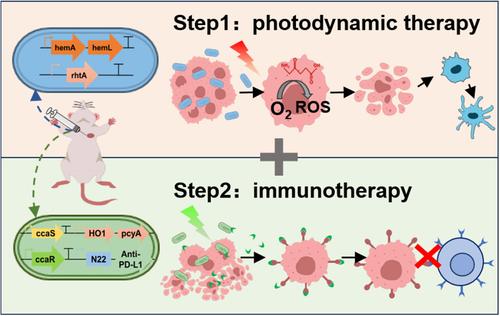当前位置:
X-MOL 学术
›
Biotechnol. Bioeng.
›
论文详情
Our official English website, www.x-mol.net, welcomes your
feedback! (Note: you will need to create a separate account there.)
Sequential delivery of photosensitizers and checkpoint inhibitors by engineered bacteria for enhanced cancer photodynamic immunotherapy
Biotechnology and Bioengineering ( IF 3.5 ) Pub Date : 2024-08-13 , DOI: 10.1002/bit.28829 Xinyu Liu 1, 2 , Yali Fan 3 , Xinyu Zhang 1, 2 , Lianyue Li 1, 2 , Chao Yang 4 , Xiaoyan Ma 4 , Guijie Bai 1, 2 , Dawei Sun 1, 2 , Yaxin Wang 1, 2 , Junyi Wang 1, 2 , Yong Li 1 , Yanyan Shi 5 , Jing Liu 1, 2 , Yingying Zhang 3 , Hanjie Wang 1, 2
Biotechnology and Bioengineering ( IF 3.5 ) Pub Date : 2024-08-13 , DOI: 10.1002/bit.28829 Xinyu Liu 1, 2 , Yali Fan 3 , Xinyu Zhang 1, 2 , Lianyue Li 1, 2 , Chao Yang 4 , Xiaoyan Ma 4 , Guijie Bai 1, 2 , Dawei Sun 1, 2 , Yaxin Wang 1, 2 , Junyi Wang 1, 2 , Yong Li 1 , Yanyan Shi 5 , Jing Liu 1, 2 , Yingying Zhang 3 , Hanjie Wang 1, 2
Affiliation

|
Engineered bacteria-based cancer therapy has increasingly been considered to be a promising therapeutic strategy due to the development of synthetic biology. Wherein, engineering bacteria-mediated photodynamic therapy (PDT)-immunotherapy shows greater advantages and potential in treatment efficiency than monotherapy. However, the unsustainable regeneration of photosensitizers (PSs) and weak immune responses limit the therapeutic efficiency. Herein, we developed an engineered bacteria-based delivery system for sequential delivery of PSs and checkpoint inhibitors in cancer PDT-immunotherapy. The biosynthetic pathway of 5-aminolevulinic acid (5-ALA) was introduced into Escherichia coli, yielding a supernatant concentration of 172.19 mg/L after 10 h of growth. And another strain was endowed with the light-controllable releasement of anti-programmed cell death-ligand 1 nanobodies (anti-PD-L1). This system exhibited a collaborative effect, where PDT initiated tumor cell death and the released tumor cell fragments stimulated immunity, followed by the elimination of residual tumor cells. The tumor inhibition rate reached 74.97%, and the portion of activated T cells and inflammatory cytokines were reinforced. The results demonstrated that the engineered bacteria-based collaborative system could sequentially deliver therapeutic substance and checkpoint inhibitors, and achieve good therapeutic therapy. This paper will provide a new perspective for the cancer PDT-immunotherapy.
中文翻译:

工程细菌连续递送光敏剂和检查点抑制剂以增强癌症光动力免疫治疗
由于合成生物学的发展,基于工程细菌的癌症疗法越来越被认为是一种很有前途的治疗策略。其中,工程细菌介导的光动力疗法 (PDT) 免疫疗法比单药治疗显示出更大的治疗效率和潜力。然而,光敏剂 (PS) 的不可持续再生和较弱的免疫反应限制了治疗效果。在此,我们开发了一种基于细菌的工程递送系统,用于在癌症 PDT 免疫疗法中连续递送 PSs 和检查点抑制剂。将 5-氨基乙酰丙酸 (5-ALA) 的生物合成途径引入大肠杆菌中,生长 10 小时后上清液浓度为 172.19 mg/L。另一种菌株被赋予了抗程序性细胞死亡配体 1 纳米抗体 (anti-PD-L1) 的光控释放。该系统表现出协同效应,其中 PDT 启动肿瘤细胞死亡,释放的肿瘤细胞片段刺激免疫,然后消除残留的肿瘤细胞。肿瘤抑制率达到 74.97%,活化的 T 细胞和炎性细胞因子的部分得到加强。结果表明,基于工程细菌的协作系统可以依次递送治疗物质和检查点抑制剂,并实现良好的治疗。本文将为癌症 PDT 免疫治疗提供新的视角。
更新日期:2024-08-13
中文翻译:

工程细菌连续递送光敏剂和检查点抑制剂以增强癌症光动力免疫治疗
由于合成生物学的发展,基于工程细菌的癌症疗法越来越被认为是一种很有前途的治疗策略。其中,工程细菌介导的光动力疗法 (PDT) 免疫疗法比单药治疗显示出更大的治疗效率和潜力。然而,光敏剂 (PS) 的不可持续再生和较弱的免疫反应限制了治疗效果。在此,我们开发了一种基于细菌的工程递送系统,用于在癌症 PDT 免疫疗法中连续递送 PSs 和检查点抑制剂。将 5-氨基乙酰丙酸 (5-ALA) 的生物合成途径引入大肠杆菌中,生长 10 小时后上清液浓度为 172.19 mg/L。另一种菌株被赋予了抗程序性细胞死亡配体 1 纳米抗体 (anti-PD-L1) 的光控释放。该系统表现出协同效应,其中 PDT 启动肿瘤细胞死亡,释放的肿瘤细胞片段刺激免疫,然后消除残留的肿瘤细胞。肿瘤抑制率达到 74.97%,活化的 T 细胞和炎性细胞因子的部分得到加强。结果表明,基于工程细菌的协作系统可以依次递送治疗物质和检查点抑制剂,并实现良好的治疗。本文将为癌症 PDT 免疫治疗提供新的视角。


















































 京公网安备 11010802027423号
京公网安备 11010802027423号